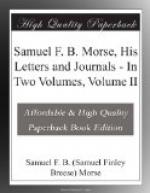But let not this disappointment cast you down, my friend. You have it still in your power to let the world know what you can do. Dismiss it, then, from your mind, and determine to paint all the better for it. God bless you.
Your affectionate friend
WASHINGTON ALLSTON.
The following sentences from a letter written on March 14, 1837, by Thomas Cole, one of the most celebrated of the early American painters, will show in what estimation Morse was held by his brother artists:—
“I have learned with mortification and disappointment that your name was not among the chosen, and I have feared that you would carry into effect your resolution of abandoning the art and resigning the presidency of our Academy. I sincerely hope you will have reason to cast aside that resolution. To you our Academy owes its existence and present prosperity, and if, in after times, it should become a great institution, your name will always be coupled with its greatness. But, if you leave us, I very much fear that the fabric will crumble to pieces. You are the keystone of the arch; if you remain with us time may furnish the Academy with another block for the place. I hope my fears may be vain, and that circumstances will conspire to induce you to remain our president.”
Other friends were equally sympathetic and Morse did retain the presidency of the Academy until 1845.
To emphasize further their regard for him, a number of artists, headed by Thomas S. Cummings, unknown to Morse, raised by subscription three thousand dollars, to be given to him for the painting of some historical subject. General Cummings, in his “Annals of the Academy,” thus describes the receipt of the news by the discouraged artist:—
“The effect was electrical; it roused him from his depression and he exclaimed that never had he read or known of such an act of professional generosity, and that he was fully determined to paint the picture—his favorite subject, ’The Signing of the First Compact on board the Mayflower,’—not of small size, as requested, but of the size of the panels in the Rotunda. That was immediately assented to by the committee, thinking it possible that one or the other of the pictures so ordered might fail in execution, in which case it would afford favorable inducements to its substitution, and, of course, much to Mr. Morse’s profit; as the artists from the first never contemplated taking possession of the picture so executed. It was to remain with Mr. Morse, and for his use and benefit.”
The enthusiasm thus roused was but a flash in the pan, however; the wound he had received was too deep to be thus healed. Some of the money was raised and paid to him, and he made studies and sketches for the painting, but his mind was now on his invention, and the painting of the picture was deferred from year to year and finally abandoned. It was characteristic of him that, when he did finally decide to give up the execution of this work, he paid back the sums which had been advanced to him, with interest.




